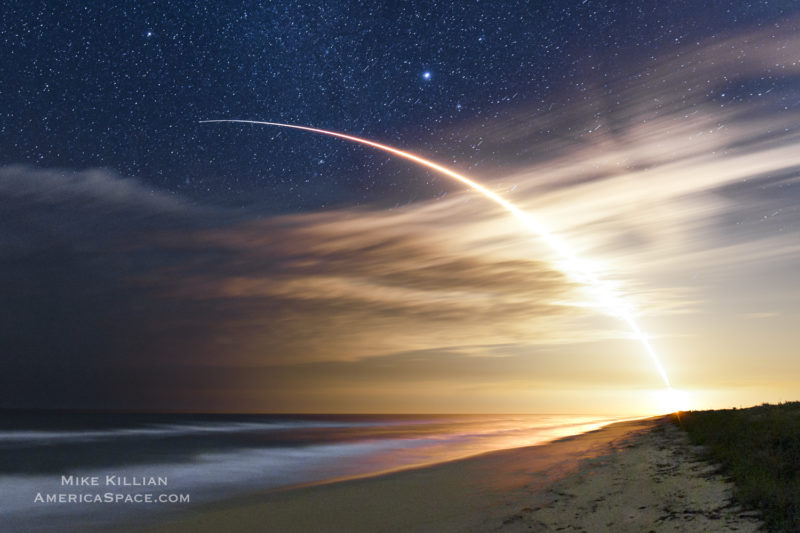
Having pounded out eight launches in a year, few could have foreseen, earlier this summer, that half as much time would elapse before one of SpaceX’s most seasoned Falcon 9 boosters took flight again. But after nearly six months on the ground, B1060—which tonight became only the fourth booster to log a ninth mission—roared aloft, laden with dozens of Starlink low-orbiting internet communications satellites and a pair of BlackSky multi-spectral imaging satellites. Eight minutes after launch, B1060 settled smoothly onto the deck of the Autonomous Spaceport Drone Ship (ASDS), “A Shortfall of Gravitas”, to wrap up SpaceX’s personal-best-beating 27th flight of the year.
Backdropped by close-to-perfect weather conditions, B1060 departed storied Space Launch Complex (SLC)-40 at Cape Canaveral Space Force Station, Fla., at 6:12 p.m. EST. In its L-1 forecast, the 45th Weather Squadron at Patrick Space Force Base pointed to low levels of moisture, with only an isolated chance of cumulus cloud development, and a similar picture for the backup attempt on Friday.
In readiness for launch, the 230-foot-tall (70-meter) Falcon 9 was rolled out from the Horizontal Integration Facility (HIF) to the pad and elevated to the vertical on Monday. Late Wednesday, B1060’s nine Merlin 1D+ first-stage engines burned furiously to life for a few seconds in a customary Static Fire Test.

It has been a remarkable year of reusability for SpaceX, with 27 missions—including tonight’s flight—having been executed by only nine booster cores, two of which recently logged their respective tenth launches. Four boosters, including B1060, have flown ninth missions in 2021, whilst only one brand-new vehicle entered the fleet and completed her first launch in June.
By any standards, it has been a remarkable endeavor. Four years ago, when SpaceX launched a previously flown booster for the first time, the achievement was an exception; a standout. As 2021 draws to a close, it has become the rule.

B1060 entered service on 30 June 2020, lifting the third Block III Global Positioning System (GPS) navigation and timing satellite towards Medium Earth Orbit (MEO) on behalf of the U.S. Space Force.
Nine weeks later, she flew a second time—cementing a record for the shortest interval between a pair of Falcon 9 launches from the Space Coast—and went on to log a third mission last 24 October. Both were laden with 60-strong batches of Starlinks. Her third flight marked the 100th successful launch of a Falcon-class rocket.

But B1060’s real record-setting credentials were concentrated into the first half of 2021. She flew SpaceX’s very first mission of the year on 7 January, with Turkey’s powerful Türksat 5A geostationary communications satellite, before being turned around in only 27 days to carry another 60-strong payload of Starlinks aloft on 4 February.
This neatly eclipsed SpaceX’s previous launch-to-launch turnaround record for a single Falcon 9 booster of only 38 days and still stands tonight. Wrapping up two more missions in March and April, B1060 became the first rocket to fly four times in four consecutive calendar months. Most recently, she flew the 88-payload Transporter-2 mission on 30 June, the one-year anniversary of her maiden voyage.

But with a notable slowdown of Falcon 9 operations through the summer and early fall, thanks chiefly to an intentional “pause” as future Starlinks were equipped with inter-satellite links, it would be almost six months before B1060 returned to the skies.
Last week, it was announced that Seattle, Wash.-headquartered smallsat provider Spaceflight, Inc., would be flying a pair of payloads for its BlackSky customer to conduct high-resolution multi-spectral commercial Earth imaging.

Already, in the summer of last year, Spaceflight inked a deal with SpaceX to secure capacity on “several” Falcon 9 missions through late 2021. The mission has been designated “SpaceX Rideshare-2” (SXRS-2), coming on the heels of the SXRS-1 payload which rode a previous Falcon 9 to orbit in August 2020.
Liftoff came on time at 6:12 p.m. EST and B1060 powered into the darkened Florida sky, creating spectacular lighting effects as it climbed to higher altitudes. As this story was being written, the two BlackSky smallsats were set to be deployed 63 and 66 minutes after launch, at an orbital altitude of 267 miles (430 kilometers), inclined 53 degrees to the equator. The 48-strong payload of Starlinks was due to be released at 89 minutes into the flight.

With the completion of tonight’s 27th mission of 2021, this year is already well-established as SpaceX’s most-flown on record, surpassing the record-setting 26 launches achieved in 2020. A total of 937 Starlinks—including the first batch bound for polar orbit—have been sent uphill on 15 dedicated flights.
Added to that list, a pair of multi-payload “rideshare” missions and two large geostationary communications satellites have been joined by two Cargo Dragons and two Crew Dragons, bound for the International Space Station (ISS), and last September’s historic all-civilian Inspiration4. Just last week, SpaceX launched its first mission to a destination in deep space: NASA’s Double Asteroid Redirection Test (DART), headed for 65803 Didymos and its small companion, Dimorphos.

Coming up next Thursday is another Falcon 9 flight, carrying NASA’s Imaging X-ray Polarimetry Explorer (IXPE), with Turkey’s powerful Türksat 5B communications satellite and the CRS-24 Cargo Dragon set to fly just before Christmas.
Completion of all three missions—whose launches will alternate between SLC-40 and neighboring Pad 39A at the Kennedy Space Center (KSC)—will draw down the curtain for 2021 with a record-breaking 30 Falcon 9 launches.





4 Comments
4 Pings & Trackbacks
Pingback:SpaceX Flies IXPE, Third Back-to-Back Night Launch from Space Coast – AmericaSpace
Pingback:CRS-24 Dragon Launches, Heads to Space Station – AmericaSpace
Pingback:CRS-24 Dragon Launches, Heads to Space Station - d-International News
Pingback:SpaceX Flies Third Falcon 9 in Three Weeks, As Multi-Launch January Continues – AmericaSpace